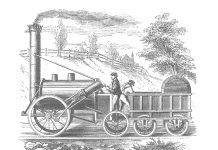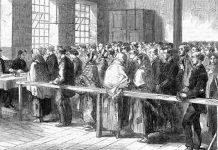About Manchester travels to Warrington and looks at the remarkable history of one of the oldest gin distillers in the country
When fire took hold of G&J Greenall’s Lousher’s Lane Distillery in 2005, the firemen were instructed to turn their hoses on the building housing the copper stills. It was doused with water for two hours and a legacy going back over two centuries was saved.
If they had been destroyed then the business was finished, Mark Parton, it’s current Managing Director tells me, “we could survive without the warehouses, the bottling plant but without those stills, we were dead”
Indeed G&J Distillers did survive, ninety eight per cent of the business was shut, but it was up and running within days , its employees racing around the region to bottling plants to keep things going. Eventually they would move into their new premises on the outskirts of Warrington, a town that had seen the origins of the business more than two hundred and fifty years ago.
Back in 1760, Thomas Dakin built a distillery on Bridge Street in Warrington, a town whose location on the main trade routes in the later decades of the eighteenth century, and with its renowned Academy, meant it was a prime location for the new venture.
The poor grain harvest that year saw the government preventing the distillation of gin stopped but in 1761 Thomas, using the latest scientific methods of the age, began distilling a gin far superior to the ‘mothers ruin’ made famous in Hogarth’s paintings, and that would attract the palettes of the new emerging middle classes.
Thomas would pass the recipe down to his son Edward and it would continue on to his grandson William, but on his death in 1860, the distillers would be taken over by another firm that had been established in nearby St Helens in 1762, a brewery by Thomas Greenall.
G&J Greenall comes from Edward Greenall’s younger brothers, Gilbert and John, Dakin’s Warrington Gin was renamed Greenall’s but continued to be made according to Dakin’s original 1761 recipe.
In 2006 the Greenall family connection was when Lord Daresbury, a descendant of founder Edward Greenall, stepped down from the post of non-executive Chairman.
In August 2013 G&J Greenall was renamed G&J Distillers by the company’s new owners Quintessential Brands. At their Warrington distillery G&J Distillers make their own gin and vodka brands as well as producing own label gins for many of the UK’s supermarket chains.
Now of its new plant in Risley on the outskirts of Warrington, comes forty per cent of the gin that we drink in the UK and twenty per cent of that which is drunk in the world. 75 different gin recipes , the capacity to distil over 11 million of litres of gin per year, processing over 800 bottles a minute and in 2015 expecting to produce 65 million bottles of spirits.
The opportunity to leave Warrington would have been easy, says Mark, but we couldn’t have done so. Employees stay with us from leaving school to retirement, and their resilience and loyalty is one of the things that makes our brand so strong. That strength reflected in a workforce turnover that is barely one per cent in a town that by all accounts is booming.

Another strength undoubtedly is that since 1760, they have only ever had seven Master Distillers, Joanne Moore is the most recent in that line, the first female to hold that post and she has been with the company for nearly twenty years, joining from university as a laboratory chemist working her way up to a position she describes today as custodian of the brand.
The flavours of gin appear engrained in her bones, as she exhibits a near obsessional quest to discover the latest flavours that will tempt the most recent converts to the beverage using her patented Gin Aroma Wheel, carefully combining the flavours of spicy, earthy, herbal, floral and fruity with the Juniper.
If you didn’t know it, gin has been on the up for the past few years, considered dead and buried not that long ago, a new generation of drinkers had found that it’s aromas and flavours compliment their modern lifestyle, supplemented by the fashion for cocktails as bartenders go that extra mile to find that next unique taste.
The same eight botanicals have been used in the gin since the days of Thomas Dakin. For those that don’t know, the basis of gin is the Juniper Berry, sacred bush, part of human gastronomy and culture since the last glaciers retreated twelve thousand years ago. Without it, Joanne tells me, you would have to call the resulting spirit a flavoured Vodka.
GJ G&J Distillers produces four unique brands, Greenalls, the product not dissimilar to that which Dakin would have produced in the eighteenth century, Berkeley Square, created to drink on the rocks, Ophir, Joanne’s latest creation and Bloom, complete with floral flavours and unconventional bottle.
Each serves a different strand of the market but what you may not know is that they are also responsible for nearly all the supermarket brands that you see on the shelves.
Is making gin a science or an art? The answer is both, created in the lab with the care and attention of the greatest Parisian perfume houses, once perfected, a grain mash is distilled once to produce a neutral spirit, then combined with the botanicals, heated to nearly eighty degrees, distilled again with the rich vapour condensed in a set of copper stills before being mixed with de-mineralised spring water to bring the alcohol content down to more acceptable levels.
G&J Distillers reaching to new heights Mark tells me. It survived the recent recession unscathed, and is now working twenty four hours a day five days a week and some weekends.







